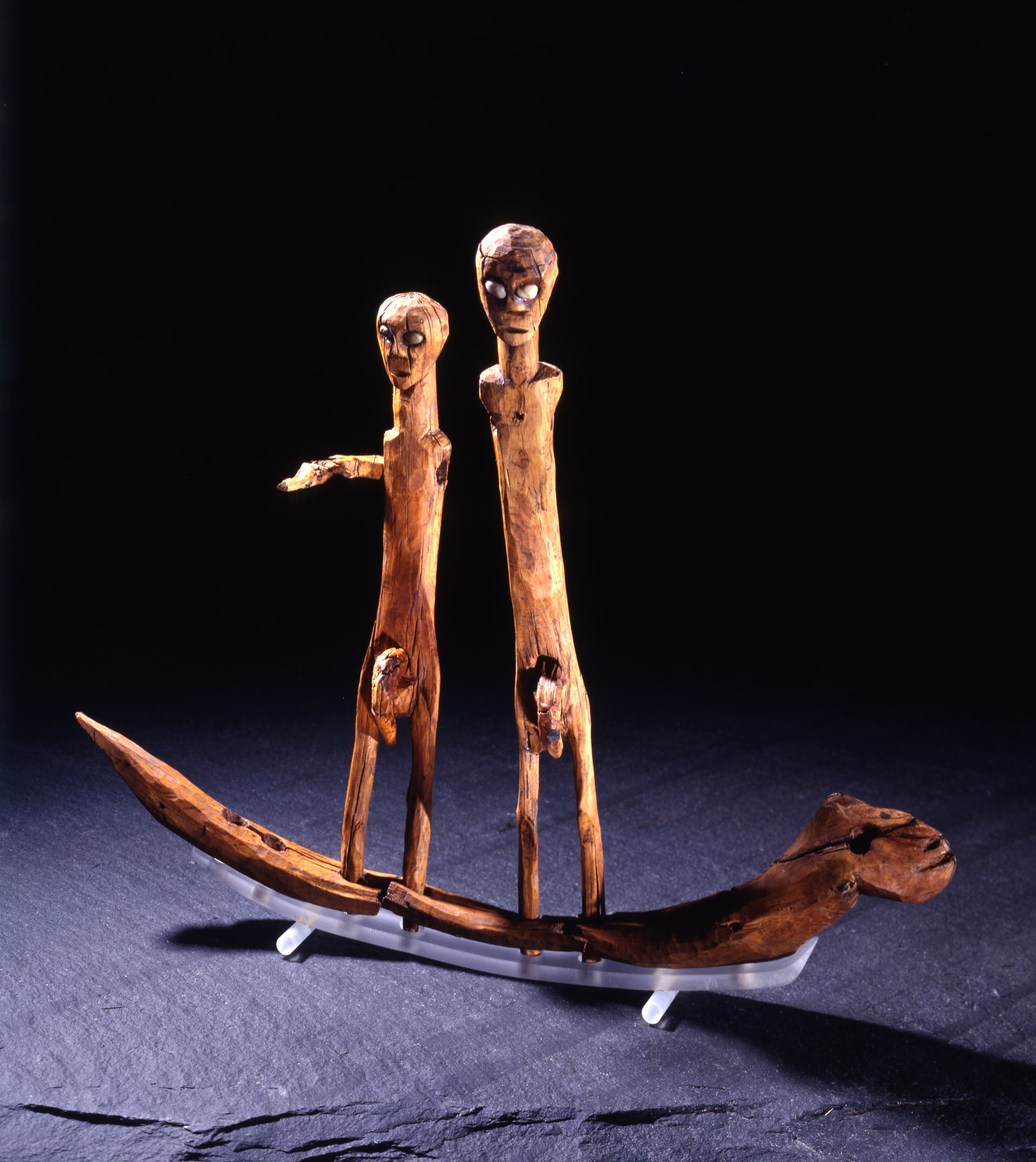
Object info
Roos Carr Figures
Late Bronze Age – Early Iron Age (606 BC – 508 BC)
Yew wood, quartzite
Where to see it
Hull and East Riding Museum of Archaeology
Accession number
KINCM:1997.134
Purchase a print or image licence
The Roos Carr Figures on Bridgeman Images
About the object
The Roos Carr Figures are a curious set of prehistoric figurines discovered in 1836. They’re between 35 and 41 cm tall and carved from yew, with inset quartzite for eyes. Two of the figures stand on a serpent-headed boat.
The discovery
In 1836, labourers cleaning a ditch at Roos Carr near Withernsea, East Yorkshire, made a surprising discovery. Two metres below the surface they found a collection of well-preserved wooden objects. These included a wooden box, a serpent-headed boat and several "warrior" figures with stone eyes. As well as various other wooden articles "too much decayed to remove".
Four figures, together with the boat, were given to the Hull Literary and Philosophical Society. Along with them came various attachments that seemed to be arms, paddles and shields.
Eventually, the objects became part of our collections at Hull Museums. We acquired a fifth figure in 1902. It seemed one of the men who discovered the figures had given this "ancient doll" to his daughter to play with!
Restoring the Roos Carr figurines
In the nineteenth century, four of the figures were fixed into the boat. The "arms", shields and paddles were also glued or nailed on wherever they seemed to fit.
Recently, the figures were conserved using more sympathetic methods. The Victorian glue and varnish were removed and the figures were taken out of the boat. Under close examination, subtle differences between the figures became clear. For example, some have nostrils while others don't. These differences (not to mention the fact there isn't room on the boat for the fifth figure!) strongly suggest there were originally two boats complete with crews.
Arms and the man
Modern examination has established that the figures are carved from yew wood and have quartzite eyes. The pieces of curved wood, previously considered to be short "arms", fit perfectly into another hole... They are actually detachable male genitalia! Perhaps it was felt that the Victorian museum visitor should be spared an anatomy lesson...
From Noah to ritual deposition
The Roos Carr figures have intrigued people ever since they first came to light. How old are they? What were they for? At various times they've been attributed to Viking invaders. And even identified as representing Noah and his family.
The question of date has been resolved by radio-carbon testing. We now know the figures are about 2,600 years old, which places them in the Late Bronze Age or Early Iron Age. But the question of their purpose remains more difficult to fathom.
Modern archaeologists think they represent votive offerings, perhaps gods or ancestor figures. The fact they were recovered from "a layer of blue clay" suggests they were deposited in or near water. This is in keeping with the wider European cult practice of depositing items such as metalwork in rivers, marshes and other marginal land.
Totally Unique?
There are nine other similar surviving figures in Britain and Ireland. They range in date from about 2500 BC to 148 BC. The figures are made from different woods: ash, pine, yew or oak. Some are definitely male. Some, like the Roos Carr figures, have removable genitalia and could be male or female. Only one, from Ballachulish in Scotland, is unambiguously female.
A Glimpse into the Past
A recent study suggests the choice of wood may relate to the god represented. Is there a link between a particular god and a type of wood? Such as Odin (or his earlier manifestation, Ull) and the yew tree. While this is an intriguing theory, there's only one certainty. The Roos Carr figures will continue to fascinate us for many years to come. Not least because of the glimpse they offer into a complex prehistoric world of ritual and religion, at which we can only wonder.
Discover more about the Roos Carrs Figures
If these prehistoric figurines have piqued your curiosity, check out this film from Documentation Assistance, Alice:

